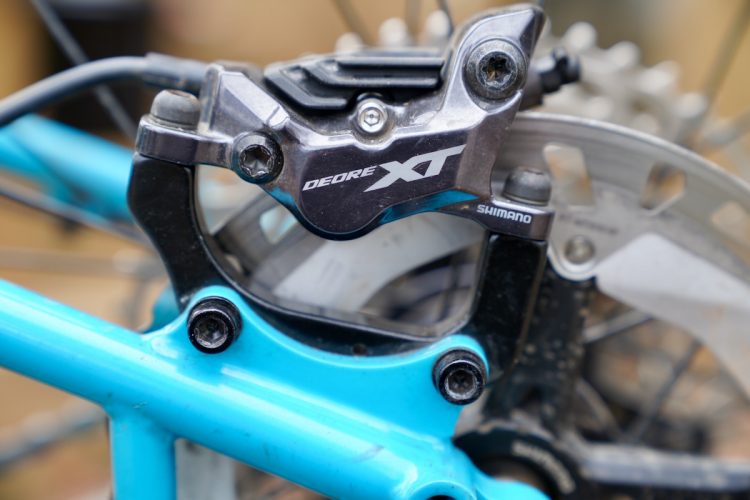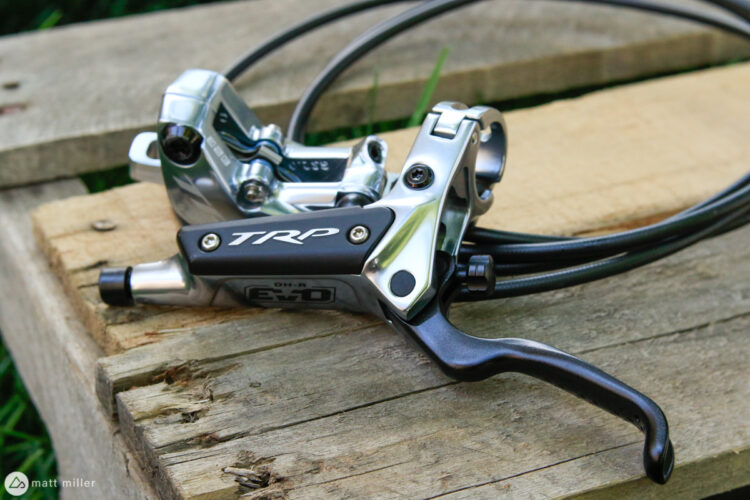
Shimano MT520 Brakes
- Price: $74 Front / $138 Rear
- Buy from Amazon
Developed for the rapidly expanding eMTB market, the BR-MT520 is Shimano’s latest 4-piston brake offering. Despite the design brief, this brake is also perfect for the budget enduro market, and will be coming specced on lots of entry level 2019 enduro bikes, including the Giant Reign 2 for example. The Shimano MT520 is technically a non-series Shimano component, though it’s essentially the Deore equivalent of their XT 4-piston brakes.
Part of what makes lower price level Shimano component groups so great is that they tend to trickle their technology down from their higher-end parts. This means that they compromise slightly on things like aesthetics, weight, and adjustability, but still retain their legendary performance and reliability. This creates great components that are affordable by us mere mortals. The new Shimano MT520 brake set is no different. For your money, you get ceramic pistons, the Shimano MT501 lever with servo-wave and I-spec II compatibility, and the monster 4-piston caliper.
The Shimano MT520 caliper is their only 4-piston caliper that doesn’t look identical to the others in their range (Saint, Zee, XT). You could even say that it looks a little sleeker, however it does use the same (non-finned) pads. It comes stock with the D01 resin pads, but you can easily upgrade to their metal pads once you’re due a pad change, adding some extra power and life. Couple this with one of their RT86 Icetech rotors as I have done, and you’ve got a killer brake set at a pretty affordable price. It’s worth noting that the Icetech-finned pads do not fit unless you trim the fins a little with a rotary tool.

In terms of fitting and setup, these are as easy as any other Shimano brake. The levers have a split clamp, so no need to remove your grips and/or shifters to fit them. The calipers mount easily, and centered up for me on the first attempt – which is not always the case with 4-pot brakes. With regard to bleeding, they bleed just as easily as any other Shimano brake on the market.
The lever feel is good. They have slightly more free-stroke than Shimano Saint brakes and Zees, but have no free stroke adjustment. The Shimano MT520 brakes have a solid bite point, though as with all Shimano brakes, this means less modulation than other brakes. I find that this is personal preference however, and I personally have no problem applying the right amount of power for the situation. You just learn to use a lighter touch than with other mountain bike brakes.
The lever blade is also the same as other Shimano brakes — I find that they fit the shape of my hand nicely and I like the short blade, though it’s not to everyone’s tastes.

There are a few drawbacks to these brakes when you compare to their more expensive siblings in the Shimano range.
As mentioned earlier, the levers lack a free-stroke adjust, and the reach adjust is not tool-free. The lever blades lack the dimpled texture of the better brakes. The callipers don’t work with finned pads without modifying the pads. The pads are fitted using a split pin, rather than a threaded bolt. The hose connects to the calliper via an in-line connector rather than a banjo, so you can’t adjust the hose angle/routing quite as nicely. Aesthetically speaking, they are fairly bland and basic.
Having said all of this, none of these things actually affect the operation of the brakes. Once you’re hammering down the trail they just work, and they work well. It’s also fair to assume that there is a weight penalty, but Shimano doesn’t provide a claimed weight for these or their XT 4-piston brakes. I can say they don’t feel noticeably heavy. If you’re a gram counter, these brakes probably aren’t on your radar anyway.

In the real world, the Shimano MT520 brake is a remarkably powerful brake for the money, and makes a great upgrade to the stock SRAM Guide R brakes on my bike. I have no trouble locking up a big grippy tire when I want to, and I find I have less arm pump when attacking steep, rough, sustained descents, with plenty of power on tap.
A 203/180mm combo works great on my trail bike, and in truth I could probably get away with a 180mm on the front. With all of Shimano’s tech aiming at reducing heat build-up, such as ceramic pistons, larger braking surface etc., the MT520 should be quite difficult to overheat. Based on my testing, this certainly holds true.
For no-frills performance in the budget-conscious trail/enduro/downhill/eMTB market, these brakes, retailing for around $100 per wheel, are an absolute no-brainer for the money. Honestly, I’ve yet to use anything better in this price bracket.
- Price: $74 Front / $138 Rear
- Available from Amazon and other online retailers





















22 Comments
Sep 23, 2019
can you please explain me how?! I have followed shimano instructions, I have seen YouTube videos on this and the fricking break still retains air inside and doesn't work properly.
Worst piece of kit I have ever bought.....
Sep 24, 2019
the tubbing is almost straight. it's almost impossible to have bubbles on the tube but they seem to persist inside the caliper and the lever.
I have already bleeded some other Shimano brakes with no problem at all!
these are making me nuts.... I have a race this Sunday.... these were supposed to be good and easy...
Sep 24, 2019
Often when bleeding the rear brake, the hose doesn't have a straight line bottom to top - there needs to be nowhere for the air to get trapped. The caliper needs to be the lowest point in the system and the lever the highest. The hose ideally would be a straight line between the two.
I often find that it helps to remove the caliper from the bike and let it hang down to ensure that it's the lowest point in the system. This can help clear any air bubbles stuck in the caliper.
Sep 24, 2019
Sep 23, 2019
Nov 24, 2018
Nov 26, 2018
Feb 10, 2019
Feb 11, 2019
Oct 30, 2018
Feb 11, 2019
Aug 19, 2019
While it didn't take long to setup the caliper and lever on the front end, getting the pads/rotor bedded in took a few weeks to get dialed in. I did use the 203 rotor from the previous setup as it was only a month old, so maybe that was it. I had a lot of squealing and I didn't have a sustained downhill long enough to get the rotor/pads hot. I was riding down my driveway braking from 15-5mph continuously, but it seemed the 2 minute climb back up was cooling the brakes too quick. The pads weren't "biting" with that digging sensation I was used to and were getting worse. With an upcoming race, I refinished the rotors and metallic pads with scotchbrite multiple times, cleaning them with alcohol after and heat treating the pads to push out contaminants. I also dremeled a lead in chamfer to the pads to aid in reduced vibration (similar to a car pad). When I did all this and did a sustained downhill run (around 10 mins after a 1000ft fire road climb), it resulted in a HUGE difference in braking power. I've done pad replacements before without changing rotors and had more success, but those were smaller area 2-piston pads, and I think getting them hot is key.
Anyway, my brakes got their full test in the ESC Sugarbush Enduro race. For me, the race was about finishing and this caliper/lever setup was super dependable the whole weekend. It handled 15kft descending in two days without a squeak. I'm actually glad the previous caliper failed as the extra power was sorely needed on the front of my bike (Process 134). To put this in perspective, the MT520 4-piston caliper noticeably bends my Pike backwards on pavement, and will lock up the tire on dirt with no questions asked. This kind of power on a 30% grade rock garden is appreciated, because you often only have a split second to place your front wheel and brake hard. I actually endo'd/OTB'd a few times in practice before I got used to the power and weight transfer required to brake hard. But that is the terrain and rider's fault, not the bike. I also didn't experience fade or floating bite point at all during the 30 mins of downhill, and the power was again, dependable. So even without finned pads, these brakes manage heat well. Super impressed.
The only issue I had is when I stand the bike vertically (to maneuver around the garage), and bring it back down, I lose all pressure and the lever goes to the bars. But one pump and pressure is back. Maybe it doesn't have enough fluid? Not a big deal practically speaking, but worth noting.
Fun Note: These brakes are spec'd on the base level 2020 Rocky Mountain Slayer 30, and while they're no SLX or XT, I'd wager a bet, given the bikes intentions, that they'd produce dependable braking on a downhill primary bike, especially with modified finned pads and RT-86 Icetech Rotors. My gripe with that bike is the MT400 hubs (WTH?).
Pros: Price, 4-Piston Power, Heat management
Cons (kinda, not really): Larger Area Pad Break-In (potentially), Pressure loss when inverted
Sep 24, 2019
Oct 29, 2019
Feb 27, 2019
Sep 25, 2019
I could not find the pads for these in stock anywhere in town, had to order them online. (I ordered the D02S pad).
Oct 29, 2019
Sep 23, 2019
Oct 29, 2018
Nov 1, 2018
Nov 1, 2018
Oct 29, 2018